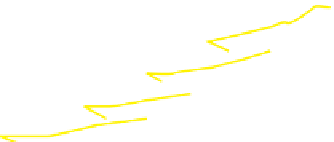Geoscience Reference
In-Depth Information
WNW
ESE
1.00
1km
Fig. 12.
Seismic section, showing truncation of Eocene strata at the offshore elongation of Hardangerfjorden, in the
Patchbank Ridge area. Truncation of Eocene strata is highlighted by the yellow arrows.
dipping towards S-SW (Fig. 9; Michelsen &
Danielsen, 1996). The clinoforms belonging to
sequence CSS-3 have an oblique geometry in the
Norwegian Danish Basin, with clinoform heights
up to 250 ms TWT.
In the Viking Graben area, the CSS-4 depocentre
is located south-east of the sequence CSS-3 depo-
centre, whereas in the Norwegian-Danish Basin it
is located south-west of the depocentre of CSS-3
(Fig. 11). Progradation continued in an eastward
direction in the northern North Sea. In the eastern
North Sea, progradation shifted to a more SW
direction compared to sequence CSS-3. In the
Norwegian Danish Basin, the clinoforms belong-
ing to sequence CSS-4 have a sigmoidal geometry
with clinoform heights up to 300 ms TWT.
Interpretation: The lower SU at the base of
sequence CSS-3 in the eastern North Sea and on
the Patchbank Ridge area indicates lowering of
the relative sea-level at the Eocene-Oligocene
transition. This is also indicated in the mid-
Oligocene, based on the SU and truncation of clin-
oform topsets in the eastern North Sea at sequence
CSS-3 top. In the eastern North Sea, base CSS-3
represents a combined SU/TS/MFS, indicated by
the downlapping pattern directly onto the SU.
Such combined surfaces imply rapid creation of
accommodation space subsequent to erosion and
potential exposure. The regional extent, thickness
variation and internal geometry of sequences
CSS-3 and CSS-4 reflect a major sediment source
in the west on the East Shetland Platform, filling
in a depocentre in the Viking Graben area by east-
ward prograding sedimentary systems. This depo-
centre migrated eastwards from Early to Late
Oligocene. The other depocentre system, in the
eastern part of the Norwegian-Danish Basin,
was shifted towards the south-west during the
Oligocene and was probably sourced with sedi-
ments from mainland Norway and filled by
progradation as seen from internal clinoform ori-
entation. The depocentres in the eastern North
Sea, revealing S-SW direction of progradation,
indicate exposure and development of a source
area in the north-north-east, as compared to dur-
ing deposition of the Chalk Group (basin configu-
ration 2) and the sequences CSS-1 and CSS-2
(basin configuration 3).
Based on the clinoform geometries, the CSS-3
sequence may have been more sand-rich com-
pared to the upper CSS-4 sequence (Bullimore
et al
., 2005). However, the oblique clinoform
geometry may also indicate limited accommoda-
tion space during deposition and longshore drift
of sediments at the platform margin (e.g. Emery &
Myers, 1996).




Search WWH ::

Custom Search